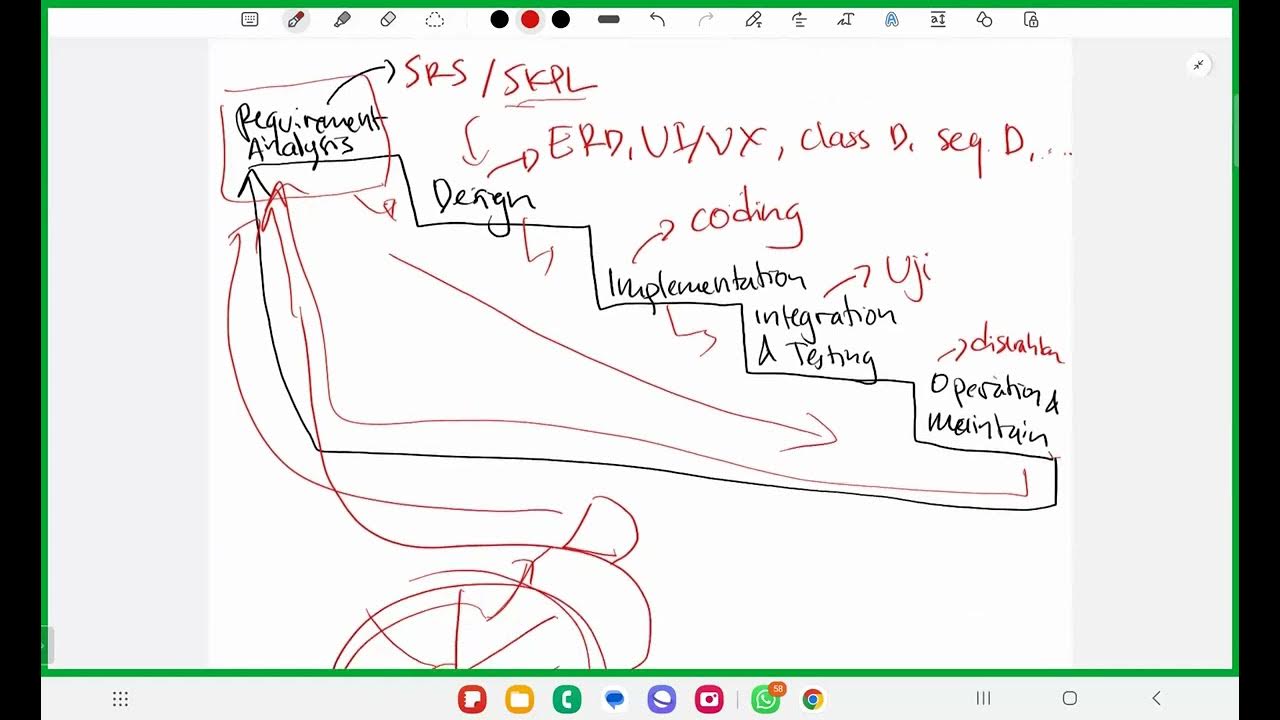Agile in Software Engineering
Summary
TLDRThis video script introduces the Agile model in software engineering, emphasizing its importance in today's fast-paced digital era. Agile focuses on quick development cycles, known as iterations, allowing for frequent product releases and immediate customer feedback. It contrasts with traditional models by promoting parallel development, minimal documentation, and a flat team structure that encourages flexibility and rapid adaptation to change. The model is widely adopted by major companies like Facebook, Amazon, Google, and Adobe, and is applicable across various industries.
Takeaways
- 🚀 Agile is a software development model that emphasizes speed and adaptability in response to the fast pace of the digital era.
- 🔄 The Agile model contrasts with traditional models like the waterfall model, which involves sequential phases and can take much longer to bring a product to market.
- 💻 Agile involves breaking down large projects into smaller, manageable chunks called iterations, which are developed, tested, and released in parallel.
- 🔧 The model allows for rapid incorporation of customer feedback, leading to continuous improvement and adaptation of the product.
- 🔄 Frequent delivery is a key advantage of Agile, with products being updated and released more often to meet changing market demands.
- 🗣️ Agile promotes face-to-face communication with clients on a regular basis, ensuring that the development direction is aligned with client expectations.
- 🛠️ The model allows for quick and frequent changes, providing a significant advantage in terms of flexibility and responsiveness to new requirements.
- ⏱️ Agile aims to minimize time constraints, reducing the overall time to market for products and updates.
- 📑 One of the disadvantages of Agile is the reduced emphasis on documentation, which can lead to maintenance challenges and potential knowledge gaps.
- 🔧 Agile does not follow a strict hierarchical structure, instead fostering a flexible team environment where all members can contribute equally.
- 🌟 The model is widely used across various industries, not just in tech, but also in healthcare, aviation, and other fields, demonstrating its broad applicability.
Q & A
What is the Agile model in Software Engineering?
-The Agile model is an approach used in software development that emphasizes flexibility, collaboration, and customer feedback. It involves breaking down large projects into smaller, manageable pieces called iterations and working on them in parallel, allowing for rapid responses to changes and faster delivery of products.
Why is the Agile model preferred by major companies like Facebook, Amazon, Google, and Adobe?
-These companies prefer the Agile model because it allows them to quickly adapt to changing market conditions and customer needs, deliver products faster, and maintain a high level of collaboration and communication throughout the development process.
What does the term 'Agile' imply in the context of software development?
-In the context of software development, 'Agile' implies the ability to move quickly and respond to changes with flexibility. It is about being able to rapidly develop, test, and release software in response to new information and feedback.
How does the Agile model differ from the traditional Waterfall model?
-The Waterfall model is a linear and sequential approach to software development where each phase must be completed before the next can begin. In contrast, the Agile model is iterative and incremental, with work being done in parallel and allowing for continuous feedback and adaptation.
What is an iteration in the Agile model?
-An iteration in the Agile model is a small, manageable piece of work that is part of a larger project. Each iteration is developed, tested, and potentially released to the market, allowing for quick feedback and continuous improvement.
Why is customer feedback so important in the Agile model?
-Customer feedback is crucial in the Agile model because it allows developers to understand the pros and cons of the product in the real world. This feedback is used to make improvements and enhancements in subsequent iterations, ensuring that the final product meets the customers' needs and expectations.
What are some advantages of using the Agile model?
-Advantages of the Agile model include frequent delivery of products, face-to-face communication with clients, the ability to make frequent and rapid changes, and reduced time constraints for product development.
What are the disadvantages of the Agile model as mentioned in the script?
-The script mentions that the Agile model may lead to less documentation, which could cause maintenance problems. Additionally, without a formal hierarchy, there might be challenges in managing the team structure and ensuring clear communication and direction.
How does the Agile model handle changes in requirements?
-The Agile model handles changes in requirements by incorporating them into the next iteration of development. This allows for flexibility and the ability to adapt quickly to new information or customer feedback without significant delays.
What is the role of face-to-face communication in the Agile model?
-Face-to-face communication in the Agile model is essential for maintaining a strong relationship with the client and ensuring that the development team is on the right track. It allows for immediate clarification of requirements and quicker resolution of issues.
How does the Agile model promote a flexible and flat team structure?
-The Agile model promotes a flexible and flat team structure by removing hierarchical barriers and encouraging all team members to contribute their ideas and work at the same level. This fosters a collaborative environment where everyone is focused on delivering the best product possible.
Outlines

This section is available to paid users only. Please upgrade to access this part.
Upgrade NowMindmap

This section is available to paid users only. Please upgrade to access this part.
Upgrade NowKeywords

This section is available to paid users only. Please upgrade to access this part.
Upgrade NowHighlights

This section is available to paid users only. Please upgrade to access this part.
Upgrade NowTranscripts

This section is available to paid users only. Please upgrade to access this part.
Upgrade NowBrowse More Related Video

Pengantar Teknologi Informasi dan Komunikasi

What Is Agile Model In Software Engineering? | Agile Methodology Explained | Simplilearn

Agile is Dead | The Agile CEO by Scrum Inc.

EKODEMY | Digital Leadership #1

Resume 5 Model Pengembangan Perangkat Lunak

1 - Pengenalan Analisis dan Spesifikasi Rekayasa kebutuhan
5.0 / 5 (0 votes)